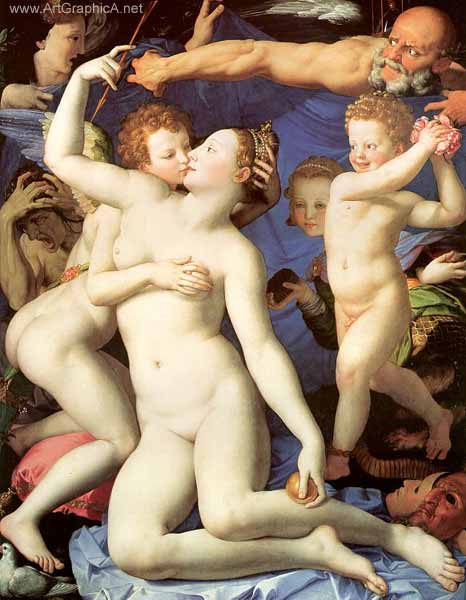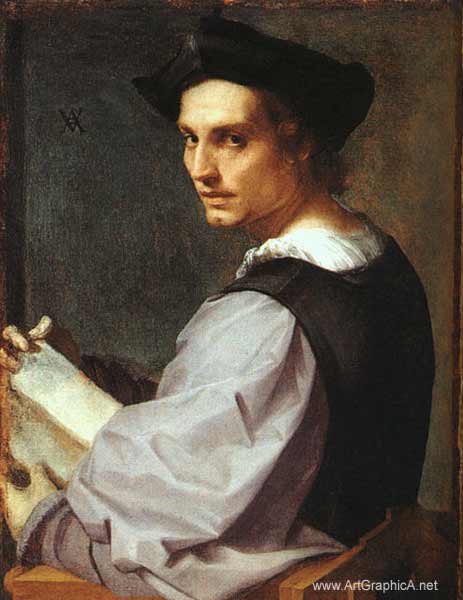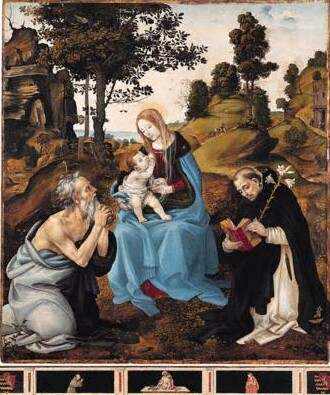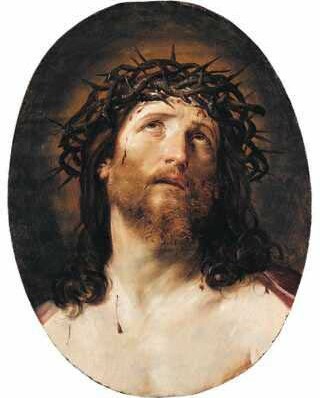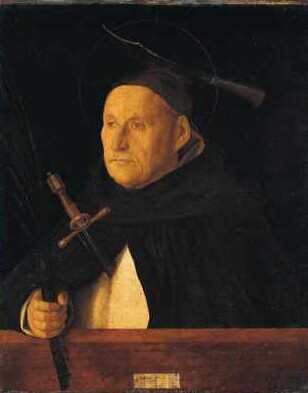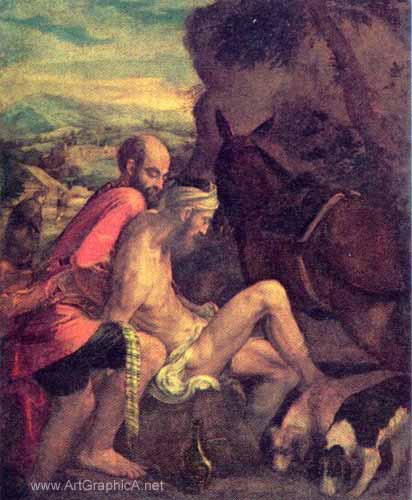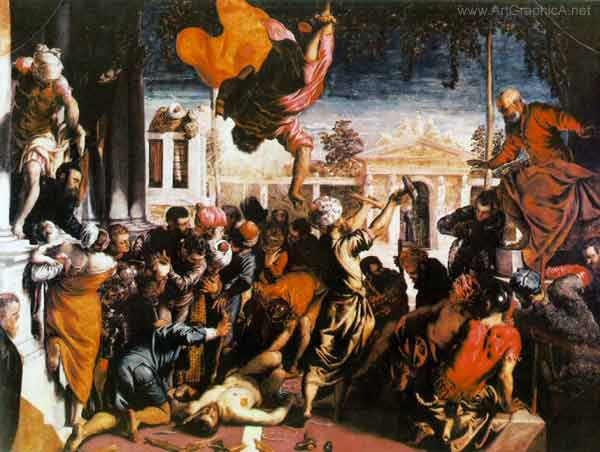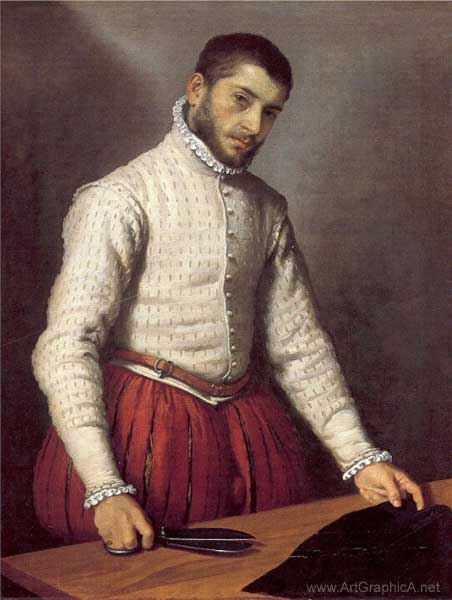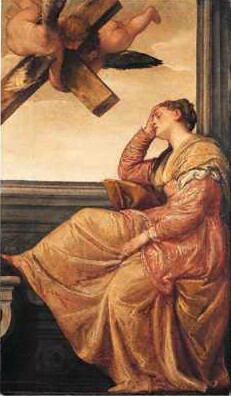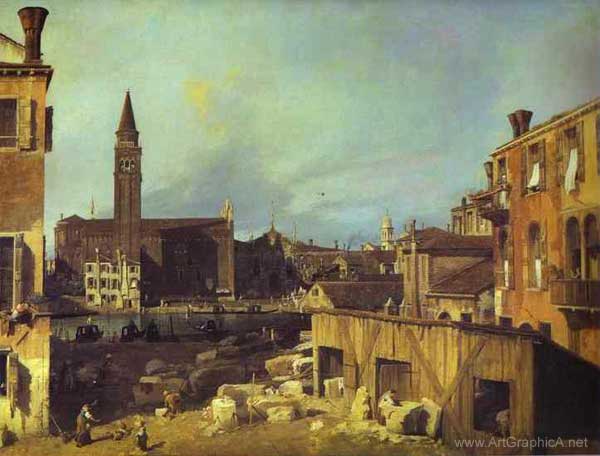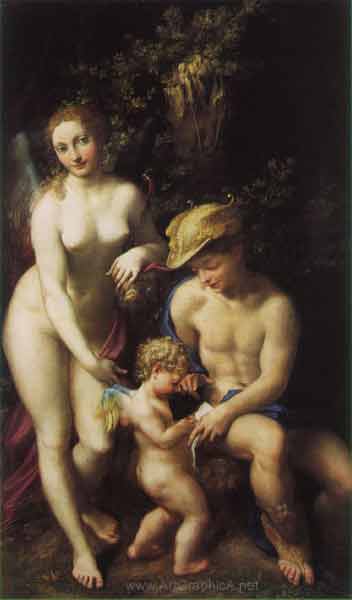PAINTING METHODS OF THE OLD MASTERS |
||||||||||||||||
|
Page 06 / 09
The Pratice of Oil Painting and of DrawingPART II METHODS OF THE MASTERSTHERE is no study more stimulating, more steadying, or more profitable to the practising student than a close and intelligent examination of the works of the masters, of the expanding of their individual powers, and the influence of each school of artistic thought on those that follow it. Many learned and exhaustive treatises have been written, dealing mainly with art in its historic and philosophic aspects, and a few by craftsmen for craftsmen, with some of which all serious painters should be acquainted ; but they are so encyclopædic, and often so diffuse, that the average student cannot find the necessary leisure to do more than consult them as books of reference. There are, however, works of the nature of Mr. Hamerton's " Graphic Arts," Eastlake's "Materials," and Mrs. Merrifield's "Ancient Practice of Painting," to which I have reason to refer, and which are indispensable to a knowledge of the developments of the Arts ; for they contain much trustworthy information on all questions relating to the materials and the methods of men whose [124] works it shall be, I hope, our pleasant duty in the course of these few pages to discuss. I propose that my reader, with this manual in hand, accompany me in imagination on a visit to the National Gallery. Technical remarks and criticisms, to have any practical value, must be made "warm" with the picture or fragment of a work under one's eye. So I may be pardoned for choosing a gallery to which repeated visits are possible to me, thus placing me in a position to select just those intimate passages of the particular works which are best calculated to illustrate the technical points to which attention is here called. The ingenious student to whom this metropolis is but a name should have little difficulty in applying the observations made before works of any given artist to the examples of such masters accessible to him-observations which I trust will be sufficiently characteristic and representative as to be so applicable. There are some pictures in the galleries which I should advise my students to copy, and the instructions given as to the method to be pursued embody some of the traditions which are preserved to us, and the result of a minute examination of the pictures themselves and the processes that appear, at least to me, to have been followed in their execution. One cannot, of course, dogmatise about methods of which the painter himself might not always in the heat of production have [125] been conscious ; but I shall give my reasons for the conclusions at which I arrive, which I trust may aid you in researches that should always be made before you attempt to copy any works of the kind. Some years ago a literary friend who was about to write a story, the hero of which was to be a painter, proposed such a visit with me to the galleries. It was no easy matter to discuss technical excellences with a writer who had but a layman's knowledge of the pictorial ; for the essential virtues of a work of art with a big " A " are just those which have no counterpart in any other medium of thought. Line, colour, technique, chiaroscuro have neither their exact literary nor musical parallels, and though in describing them we seek the aid of terms that more properly appertain to these other arts, the specific significance of such terms is adequately followed only by those conversant with the painter's craft. The cultivated observer may be moved to admiration by a well-balanced composition, a fine flow of lines, without possessing the power to probe the secret of their appeal. A happy colour scheme is enjoyed by many, but the why and the wherefore are perceived by him alone who has attempted such harmonies ; and so it is with the subtleties of tone, colour-modelling, freedom of handling, learned draughtsmanship, and with all the aesthetic accomplishments, in which the conceptions of the masters are clothed. You, my reader, will have [126] some idea of these purely æsthetic qualities, gained by the practice of your craft; and by seeking models in which are revealed the highest expressions of which the simple materials are capable, in the hands of your great predecessors, you will increase your resources and augment the critical faculty inseparable from serious achievement. The earliest and Gothic pictures are so far removed from modern practice that it will be advisable to concentrate our attention on the more developed forms ; for, with the exception of a few obvious differences, the practice of the earlier oil-painters in Italy and elsewhere is borrowed from Flemish crafts, to the main principles of which allusion is made. ANGELO BRONZINO VENUS, CUPID, FOLLY, AND TIME
Brilliancy, the outcome of a perfect technical method. XXVIII. VENUS, CUPID, FOLLY, AND TIME. AN ALLEGORY. BY ANGELO BRONZINO CHAPTER II ITALIAN SCHOOLSANGELO BRONZINO" VENUS, LOVE, AND FOLLY."-In the large Tuscan room at the National Gallery this picture detaches itself from its surroundings by reason of its extraordinary brilliancy. You will no doubt be struck by the fulness of the panel. This amplitude, like the head on a fine Greek coin that practically fills its circle, is due to the influence of Michael Angelo, the painter's master, two of whose unfinished works are among the treasures of the National Gallery. When chaperoning my literary friend around these Galleries, I found myself, when asked why we stopped before certain works, using repeatedly the word " luminosity." This luminosity is without doubt the supreme test of the painter's craft. Age will give a "patina," and enhance that glow of light in work that has been carefully wrought; on the other hand, it obliterates much of the original brightness when the method followed was ill-considered or careless. There is no caprice in Nature's apparent favouritism. [130] The figure of Venus, being in full light, has no unnecessary accents to impair its largeness; for over-modelling is inimical to brilliancy and freshness, and that brilliancy is again enhanced by the subduing of all other incidents that might compete if lighted equally, such as the torso of the cherubic Folly, which is no less tenderly and broadly modelled than the principal figure. One can only attribute the freshness of the flesh tones to a pure white under-painting in which there was little oil (for oil tends to darken), and to the very direct completion of each large passage. The unity of the whole aspect would not be preserved as it is had there been many succeeding re-paintings. The actual colour is glazed in some instances, and used with but slight opacity in others. The transparent drapery on the figure of Venus is thinly wrought over dry paint, as are the leaves that cut across the outline of the Cupid. Its inexorable drawing is undoubtedly due to the use of a completed cartoon, as there are no signs of change in the original intention, which after so many centuries we should not fail to detect. The making of a cartoon for every picture was a common practice with the masters of decorative design. Fresco-painting, on which most of them were engaged, exacted such a provision. It was well-nigh impossible to make changes in the original composition when working on the intonaca or wet plaster surface ; and it is to the survival of this habit that the brightness of the earlier works owes so much. ANDREA DEL SARTO
Remark the beautifully drawn foreshortened mouth, and the finely disposed arrangement of the figure in its setting. XXIX.PORTRAIT OF A SCULPTOR. BY ANDREA DEL SARTO ANDREA DEL SARTOThis is an exquisitely constructed portrait. The unerring precision of the mouth is a fine example of foreshortened drawing. The tonal relation of the face and neck to the white shirt, the transparency of the shadows, the slightly impastoed touches following and accentuating the modelling under the near eye, are other technical points to note. In copying this picture, model it first in a cool " grisaille," taking care to keep the shadows lighter than they appear; the subsequent glazes will bring them to the requisite depth, and so you will retain the translucent effect in them, so remarkable in the neck. Meanwhile, until you are prepared to make such a copy, draw it in your sketch-book, not only the head, but the whole arrangement, for the figure is placed in its setting with great artistry. An inch more on this side or that would upset its perfect balance, which fact is in itself a good test of the justness of design. [134]FILIPPINO LIPPI This composition is perhaps the most beautiful of its kind in the galleries. The painting is of the primitive order. The white gesso ground, as with the Flemish painters, is a passive agent, kept free for the lights, like white paper in water-colour painting. The darks are applied thickly with much varnish, so that they stand higher up on the surface of the panel than do the lights. It is drawn with the resolute outline usual with the Gothic painters, and with later decorators, and is then prepared in a brown and black monochrome. The colours are glazed over the lighter passages, and, in the case of the St. Jerome, semi-opaquely modelled. There are signs in the drapery at the right bottom corner of a change in its arrangement. Here it is of little importance, but it demonstrates the danger of such changes in any prominent part of a work. The oil dries out of the colour in the course of time, and the pigment is thereby so thinned as to become transparent. FILIPPINO LIPPI
THE VIRGIN AND CHILD. ST. JEROME AND ST. DOMINIC ADORING THE INFANT CHRIST
A beautiful decoration. XXX.THE VIRGIN AND CHILD, ST. JEROME AND ST. DOMINIC, ADORING THE INFANT CHRIST. BY FILIPPINO LIPPI GUIDO RENI ECCE HOMO
An example of thin, rapid painting over a grisaille preparation. XXXI.ECCE HOMO. BY GUIDO RENIGUIDO RENI [139] GUIDO RENIThe " Ecce Homo ! " of Guido is painted over a white and grey ground, very thinly and freshly, with every indication of having been accomplished at one sitting over the dry preparation, judging by the running paint of the shadows washed over the lighter ground, and by the frank little touches beside the tearful eye. A small Gainsborough head of his daughter in the British Section is very like this in execution, and it is interesting to compare them. There are other works with great names in these first four galleries, which you will no doubt study at your leisure, but I prefer to take you now into the great Italian gallery, which contains mainly Venetian pictures. [140]CHAPTER III THE SCHOOL OF TITIAN"THE PORTRAIT OF A POET," with a background of laurels, ascribed to Titian, is a most impressive rendering of a sensitive and thoughtful head. There is no bravura in the handling of it, and except on the white shirt and the glove, no sign of paint. And how it gains by such masterly reticence ! Obtrusively clever brushwork, as with Frans Hals, infuses vitality, and may make of an uninteresting head an interesting picture ; but with so sympathetic a subject as this poet, it would be unwise for the artist to distract from the full enjoyment of its innate delicacy by drawing attention to any obvious skill in its production. The Venetians knew how to import an unequalled gravity and nobility into their portraiture. Apart from the conclusions to which the skilled Venetian restorers of the early part of the last century have arrived, we have some definite records of Titian's manner of painting. We shall not necessarily paint Titians because of this knowledge, but in making copies of his works such knowledge, as far as it goes, is indispensable. [141] This applies equally to the copying of works of any master whose method has been handed on to us. Presumably Titian, who lived nearly ninety years, deviated somewhat from the practice of his master Bellini. His is a more solid style ; but on comparing the two we find that the main principles of their craft are identical, and, with the exception of Paolo Veronese and Tintoretto, constitute the basic conditions of Venetian oil-painting of the period. TITIAN'S METHODIt is found that the ground or first covering of the canvas was of gesso, sized, often of the colour of terra-rossa, possibly a pigment resembling our light red, the actual colour painted over being of a slightly reddish white. In a similar colour, very solidly, the flesh in the abozzo (equivalent to the French ébauche, or our "laying in") was done, and the rest of the picture in a faint but firm rendering of the final local colouring. The abozzo was placed in the dew and sun to dry often for months, until it was sufficiently hard to allow of a rubbing down of the flesh tints with pumice, or of a scraping perfectly even with a knife, for Titian's flesh is smooth. If after this long interval a fresh eye detected faults or the need for change, adequate preparation was made. [142] The rich glazes and alternate scumblings were then applied with the fingers and thumb, and finally the whole was gilded either with a golden varnish or with asphaltum. In some instances the restorers have found indications of eight or" nine separate applications of pigment more or less solid ; and the toning of the flesh they attribute to the darkening action of the oil in the colours so frequently superposed. The glowing effects favoured by the Venetians are to be seen any day in Venice, reflected from the marble-fronted buildings on to the people and objects in the houses. Giovanni Bellini's " Peter the Martyr," a fine delicate work by Titian's master, recalls the glowing light of those interiors. "Bacchus and Ariadne."-Of the composition of this great picture I shall treat later. The account of Titian's method, as recorded, is consistent with the result. One cannot pretend to do full justice to a painting so rich in achievement and of such unending charms ; let me try, however, to direct your attention to some of its technical excellences. To begin with, in the figure of Ariadne, note the draughtsmanship and the subtle tone of the profile outlined against the outstretched hand; the texture of the loose hair ; the modelling of the light on the shoulder above the band of red ; ' and the warm greenish-grey tones against its lower edge. Note, again, the gracefully radiating [145] folds of the blue drapery held around the figure by the left hand ; the toning of the flesh and other colours by contrast with the white linen ; and then the harmonising of the blue and red by means of a rich glaze of asphaltum. Now remark the glitter and sparkle given to the whole scheme by those wonderful flying folds above the arm of the Bacchus, crowning and leading the eye across the whole composition. It is the keystone of the arch. Cover it out with your hand and you will realise the important part it plays here, with its rich glazes of lake on a golden ground against the warm blue of the sky. You will note that, unlike the more modern painters, Titian introduces no shining lights in his flesh, yet it suffers no loss of round-ness or solidity. It is the bigger view. Observe the joyous handling of the little satyr in the foreground ; the realism of the silver timbrel against the blue and gold harmony ; and, what is perhaps the most notable achievement of all, the underlying grey in the leg of the Bacchante. Such a quality of grey, seen in some form or other in the work of nearly all the great colourists, cannot be realised in direct painting. Only fine tones beneath a warm translucent covering will give it. Then those majestic clouds tied together with long decorative horizontals, the blue hills and the middle, distance broken with accidental sunlight and shadow in a landscape that has rarely [146] been surpassed, and certainly not equalled by earlier painters. The loading of pigment is reserved for draperies and accessories. It will be seen in the impastoed white cloth around the bronze vase, which is again warmed with asphaltum. There are no signs of changes made, such as are evident in the small " Christ and Magdalene " picture by the same master ; and its absolute completeness and maturity more than justify the long and patient processes of its production. Pilgrimages to this picture cannot be too frequent, for what the French call trouvailles- fresh finds-will reward each succeeding visit to it. GIOVANNI BELLINI ST. PETER MARTYR
An example of the glowing light characteristic of Venetian interiors. XXXII. ST. PETER MARTYR. BY GIOVANNI BELLINI SEBASTIANO DEL PIOMBO"The Raising of Lazarus" appears to have been done in a similar method, except that the ground has little of Titian's solid light, and is by contrast a heavy chocolate colour. In exaggeration of one of the master's devices, everything has been sacrificed to the white of the draperies, by a too free use of asphaltum over most of its surface. BASSANOThe student, when painting the nude from nature, should make an exhaustive study of "The Good Samaritan," one of the gems of our collection; and remember in copying it that the [149] method is that of Titian, although the greys are somewhat cooler in Bassano's flesh. Nothing could be finer than the foreshortened torso, the modelling of the bent leg, the two heads, and the swing of the interwoven figures. Much that has been said of the " Bacchus and Ariadne " is applicable to this canvas, and were it not for the more sparkling flesh impastos, it might well pass for a work of Titian himself. JACOPO DA PONTE THE GOOD SAMARITAN
National Gallery The scheme of colour throughout this picture is of great beauty, and the painting of the nude figure of rare distinction. XXXIII.THE GOOD SAMARITAN. BY JACOPO DA PONTE
TINTORETTO"The Legend of the Milky Way," possibly a ceiling panel. This is by no means a representative example of that prolific and virile master. His "Miracle of St. Mark " and his " Crucifixion," in Venice, are two of the great pictures of the world, brilliant and glowing in. colour ; and it is recorded of them that they were accomplished with almost incredible rapidity. According to some experts, the " St. Mark " was painted in egg tempera-that is to say, the medium used was yolk of egg ; but once such tempera is varnished there is nothing to distinguish it from oil-painting. We incline to take for granted much that is said about methods with insufficient proof. By a careful scrutiny of the external evidences, it is easy to prove that many of these assertions are without foundation. One feature to which I desire to attract your [150] attention in the picture before us is the nature of the cast shadow across the central nude, a transparent glaze over the solidly and more lightly modelled torso. Here it is obviously cast by the flying figures; but frequently the source of such shadows is not traceable in the design itself. When Paolo Veronese was asked for the origin of such a shadow without apparent reason on a group that told dark against a light mass, he said, there is "a passing cloud." Titian was one, if not the first, to break up landscape masses with accidental light and shadow, as in the " Bacchus and Ariadne," and its aid is resorted to by both landscape and figure painters in concentrating the light interest on a main incident, on the heads and shoulders of portraits, to obscure distracting detail, and to invest with mystery, when discreetly used, what might often be bald and unpicturesque without it. In the corner of this picture there is a wonderful note of colour quality in the wing of the cherub. " ST. GEORGE AND THE DRAGON."- A daring harmony, made of the blue dress and the rose of the flying drapery of the running female figure, draws one to this picture. The madders, glazed over a white ground with touches of Naples yellow like golden threads interwoven, make of these folds a glorious chromatic scheme. TINTORETTO THE MIRACLE OF ST. MARK
Academy, Venice XIV.THE MIRACLE OF ST. MARK. BY TINTORETTO [153] MORONILet us compare this master's famous " Tailor " with his " Lawyer " and " Ecclesiastic." In " The Tailor " the grey black of the under-painting asserts itself overmuch, and is an illustration of the difficulty a painter experiences in evading the influence of his underlying colours. Perhaps in this case the glazes have vanished. When oil and not varnish is used in glazing the carnations, they may evaporate as in this picture. It is, in fact, never wise to trust to one glazing to which a partial scumbling is not added. There is an account in Mrs. Merrifield's work of the removal of a glass from a picture by Titian, which, until the glass was taken from it, appeared to be fully coloured. It was found, however, that the glazes had flown from the canvas and had adhered to the glass. In a like manner, owing to evaporation or the ignorance of restorers, many of Sir Joshua Reynolds's portraits are now colourless. For all that, the faded flesh of Moroni's " Tailor " and Sir Joshua's monochromes, notwithstanding the loss of their warm transparent hues, are finer pictures than many the colours of which are still in good condition ; for a well-wrought grisaille is in itself a beautiful thing. In spite of this very noticeable grey ground of the " Tailor's" head, there are some who assert that Moroni painted in colour direct. Rarely is direct [154] colour painting without an underlying preparation to be found in the earlier works, except with Frans Hals and a few others of less importance, and with Velazquez only in his latest stage, and then not often, as we understand direct painting to-day. Walk round the galleries on Students' Days and compare the opacity of the copies done in direct colour with the translucent quality of the originals, and a good lesson in methods can he taken to heart. Doubtless the other portraits of Moroni were prepared in the same way as the " Tailor," hut with more solid pigment added in the final stage. The warmly toned face of the " Lawyer " is well contrasted with the solid white of the ruff. Such a tonality in the flesh is more frequent with the Italians than with the Flemish painters, the fairness of whose sitters often induced them to lower the white around the neck that the face might lose less of its brightness by the contrast. And as a rule there is more clear light, though not necessarily a greater luminosity, in the flesh of the Rubens school. MORONI THE PORTRAIT OF A TAILOR
National Gallery In this picture the use of a monochrome is evident. XXXV. THE PORTRAIT OF A TAILOR. BY MORONI [157] CHAPTER IV THE ITALIAN SCHOOLPARIS BORDONE"THE PORTRAIT OF A LADY" has in it no white linen to dull the dazzling neck and bosom, or the scintillating crimson satin. When we consider that it was done about three and a half centuries ago, we may well wonder at the perfection of the craft in its execution. There are few finer colourists than Bordone at his best. In this picture you will readily recognise the clear white ground with the rich madder glazes in the dress, and that oneness in the painting of the skin so characteristic of the best Italian work. PAOLO VERONESE" The Vision of St. Helena " may serve to illustrate Paolo Veronese's method, although probably painted not by the master himself, but by his pupil Battista Zelotti. According to the reliable evidence of Boschini and the experience of the Venetian restorers, Paolo's abozzo was in the middle tints-that is, he selected, much in the way I have [158] endeavoured to impress on you in painting from the life direct, the tone and colour that stands midway between the lights and the deeper halftones. On these he impastoed, not heavily but with a full brush, the highest lights, and then glazed the shadows, which with him were rarely deep; for he was above all a decorator, and the darks in pure decoration are made rather of the flat masses of coloured draperies than of the play of light and shade. The " St. Helena " is on a rough unprimed canvas ; probably a thin coat of size is all that lies between the paint and the threads. Paolo Veronese and his pupils favoured a coarse-textured ground, which enabled them to obtain a greater variety of surfaces. The sky and flesh here, unlike the draperies, are somewhat smooth. The skirt, an interesting study in broken colours, is treated with a full brush in the lights on it, the reddish glazes being caught in the deep interstices of the canvas. One of Paolo Veronese's finest works is "The Family of Darius at the Feet of Alexander." On a close examination of this picture it will be seen that the damasked patterns are painted over the dry first colouring, and the lights on the folds worked over or into the colour glazes ; and a distinct outline is drawn around the figures, which imparts a decorative value to the whole. Besides this picture and "The Adoration of the Magi," the National Gallery contains four ceiling panels, in which the figures are much foreshortened. [163] A unity of colour is preserved throughout this series by what appears to be an under-painting of a greenish grey. The silveriness of Paolo's colour, which distinguishes him from most other Venetians of his time, schemes well with the great gilt mouldings of Venetian ceilings and rich surroundings. With the prudence which distinguishes the great men, it was his wont to paint his mineral colours either in distemper or varnish, for oil dipicturesed them. PAOLO VERONESE ST. HELENA. VISION OP THE INVENTION OF THE CROSS
National Gallery An exquisite example of decorative line and broken colour in the draperies. XXXVI. ST. HELENA. VISION OF THE INVENTION OF THE CROSS. BY PAOLO VERONESE CANALETTOAmong the Canalettos of our gallery is a view of "Venice," which is one of the master's finest examples. In it, remark the nature of the great shadows cast by the house on the left and by the campanile on to the body of the church. Then, again, the tonality of the rest of the picture with the sunlit masonry and other white stone passages. The dark brick of the church, although in sunlight, is low in tone and has that sense of weight and body due to justly contrasted values. The liquidness of the water is superb. Here are none of the ruled, upright, and perspective lines to be seen in the " Grand Canal " from the same master's brush, which, to be hypercritical (for the painting is a fine one), detract from the solidity of the buildings and give an air of thinness and incompleteness to the work. In mural decoration outlines are reasonable. The flatness felt by their use is desirable, for [164] much relief is not to be sought when a picture is to be considered as part of the wall itself. Of this I shall treat in the closing chapter, but I wish you to remember that artifices that have their proper functions to fulfil in one form of art may be hurtful when applied to another. We must seek for the origin and purpose of these conventions, and not use them indiscriminately. CANALETTO A VIEW IN VENICE
National Gallery This work well illustrates the sense of solidity and the weight-giving effect of carefully contrasted tone values. XXXVII. A VIEW IN VENICE. BY CANALETTO CORREGGIOBefore leaving the Italians, let us look for the Correggios in the Lombard room, the "Mercury, Venus, and Cupid " and " La Vierge au Panier." If one were asked to date these pictures, knowing nothing of their history, one might place them well in the seventeenth century, so highly is the art in them developed. Still more extraordinary are they for the early sixteenth century when they were executed; and it says much for the perfection of their craft that they are still so fresh and luminous. Leonardo da Vinci, whose art may be studied in the very beautiful " Virgin and the Rocks," wrote that a painter's line was a mathematical line and that it should nowhere be seen, for one colour began where the other ended. This fusion of the edges of the flesh with their setting is of the essence of Correggio's technique, sometimes to a point overdone; for, although he displays enormous technical skill and great charm of colour, [167] one often misses in his work a feeling of the bones beneath the flesh, and that human grip which one expects to find in the conceptions of the greatest masters. There is an excess of softness, amounting to prettiness, in his pictures of the " Vierge au Panier " type. For this reason, when several of his rare works are seen together they are somewhat disappointing. As a colourist and a technician he is supreme, but his lack of vigour is distracting. Such I feel would be the criticisms levelled at his picture were they by a modern. And it is incomprehensible to me that different standards should obtain for any mature works, whether by deceased or living men. CORREGGIO VENUS, MERCURY, AND CUPID
National Gallery Sweetness and purity of colour that a perfect technical method has preserved for three centuries and a half. XXXVIII.VENUS, MERCURY, AND CUPID. BY CORREGGIO [168]
|
||||||||||||||||
